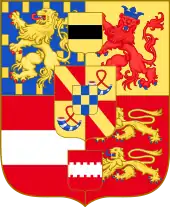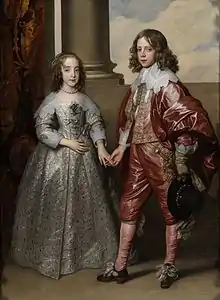William II, Prince of Orange
William II (27 May 1626 – 6 November 1650) was sovereign Prince of Orange and Stadtholder of Holland, Zeeland, Utrecht, Guelders, Overijssel and Groningen in the United Provinces of the Netherlands from 14 March 1647 until his death three years later.[1] His only child, William III, reigned as King of England, Ireland, and Scotland.
| William II | |
|---|---|
 William II, Prince of Orange (1651) by Gerard van Honthorst | |
| Prince of Orange | |
| Reign | 14 March 1647 – 6 November 1650 |
| Predecessor | Frederick Henry |
| Successor | William III |
| Stadtholder of Holland, Zeeland, Utrecht, Guelders, and Overijssel | |
| Reign | 14 March 1647 – 6 November 1650 |
| Predecessor | Frederick Henry |
| Successor | William III |
| Stadtholder of Groningen | |
| Reign | 14 March 1647 – 6 November 1650 |
| Predecessor | Frederick Henry |
| Successor | William Frederick |
| Born | 27 May 1626 The Hague, Dutch Republic |
| Died | 6 November 1650 (aged 24) The Hague, Dutch Republic |
| Burial | 8 March 1651 |
| Spouse | [1] |
| Issue | William III |
| House | Orange-Nassau |
| Father | Frederick Henry, Prince of Orange |
| Mother | Amalia of Solms-Braunfels |
| Religion | Calvinism |
Early life

William II, Prince of Orange, was the son of Frederick Henry, Prince of Orange, and Amalia of Solms-Braunfels.[1] Frederick Henry was the youngest son of William the Silent (stadtholder 1559–1584); his older half brother Maurits of Nassau was stadtholder (1585–1625); he was stadtholder from 1625 to 1647.[2] The stadtholders governed in conjunction with the States-General, an assembly of representatives from each of the seven provinces, but usually dominated by the largest and wealthiest province, Holland.
On 12 May 1641, William married Mary, Princess Royal,[1] who was the eldest daughter of King Charles I of England,[3] in the Chapel Royal of Whitehall Palace in London. William was not yet fifteen, while Mary was just nine at that time.[lower-alpha 1]
Reign
In 1647, his father, Frederick Henry died,[2] and William II succeeded to both his hereditary titles and his elective offices as stadtholder of six of the seven provinces: Holland, Zeeland, Utrecht, Guelders, Overijssel and Groningen.[1]
The Netherlands at this time was engaged in the Eighty Years' War against Spain for its independence. Under Frederick Henry, the Netherlands had largely won the war, and since 1646 had been negotiating with Spain on the terms for ending it.
The negotiators agreed to the Peace of Münster in 1648, but William opposed acceptance of the treaty, even though it recognized the independence of the (northern) Netherlands, because it left the southern Netherlands in the hands of the Spanish monarchy. A separate peace furthermore violated the alliance with France formed in 1635. However, the States of six provinces voted to accept it.
Secretly, William opened his own negotiations with France with the goal of extending his own territory under a more centralized government. In addition, he worked for the restoration of his exiled brother-in-law, Charles II, to the throne of England.
In 1650 William II became involved in a bitter quarrel with the province of Holland and the powerful Regents of Amsterdam, Cornelis and Andries Bicker and their more diplomatic cousin Cornelis de Graeff. With the Peace of Münster, the Regents wanted to reduce the army, saving money. That would also diminish William's authority. William imprisoned eight members of the States of Holland (including Jacob de Witt) in the castle of Loevestein. In addition, he sent his cousin, Willem Frederik of Nassau-Dietz with an army of 10,000 men to seize Amsterdam by force. Bad weather foiled this campaign, but Amsterdam did give in.[5]
William served as stadtholder for only three years, until he died of smallpox in 1650. His only son William was born one week after his death. This was the beginning of the First Stadtholderless Period. His son succeeded him in 1672 as stadtholder and later, in 1689, also became King of England.[6]
Arms
William II used the following arms during his time as prince of Orange, Stadholder or Holland, etc., and Captain-General:
 The coat of arms used by Frederick Henry, his son William II, and his grandson William III before becoming King of England[7]
The coat of arms used by Frederick Henry, his son William II, and his grandson William III before becoming King of England[7]
Depictions
 Double portrait to commemorate the betrothal of William and Mary Henrietta Stuart, by Anthony van Dyck.
Double portrait to commemorate the betrothal of William and Mary Henrietta Stuart, by Anthony van Dyck. William II of Orange and Mary Stuart, Princess Royal.
William II of Orange and Mary Stuart, Princess Royal.
Ancestors
| Ancestors of William II, Prince of Orange | |||||||||||||||||||||||||||||||||||||||||||||||||||||||||||||||||||||||||||||||||||||||||||||||||||||||||||||||||||||||||||||||||||||||||||||||||||||||||||||||||||||||||||||||||||||||||||||||||||||||||||||||||||||||||||||||||||||||||||||||||||||||||||||||||||||||||||||||||||||||||
|---|---|---|---|---|---|---|---|---|---|---|---|---|---|---|---|---|---|---|---|---|---|---|---|---|---|---|---|---|---|---|---|---|---|---|---|---|---|---|---|---|---|---|---|---|---|---|---|---|---|---|---|---|---|---|---|---|---|---|---|---|---|---|---|---|---|---|---|---|---|---|---|---|---|---|---|---|---|---|---|---|---|---|---|---|---|---|---|---|---|---|---|---|---|---|---|---|---|---|---|---|---|---|---|---|---|---|---|---|---|---|---|---|---|---|---|---|---|---|---|---|---|---|---|---|---|---|---|---|---|---|---|---|---|---|---|---|---|---|---|---|---|---|---|---|---|---|---|---|---|---|---|---|---|---|---|---|---|---|---|---|---|---|---|---|---|---|---|---|---|---|---|---|---|---|---|---|---|---|---|---|---|---|---|---|---|---|---|---|---|---|---|---|---|---|---|---|---|---|---|---|---|---|---|---|---|---|---|---|---|---|---|---|---|---|---|---|---|---|---|---|---|---|---|---|---|---|---|---|---|---|---|---|---|---|---|---|---|---|---|---|---|---|---|---|---|---|---|---|---|---|---|---|---|---|---|---|---|---|---|---|---|---|---|---|---|---|---|---|---|---|---|---|---|---|---|---|---|---|---|---|---|
| |||||||||||||||||||||||||||||||||||||||||||||||||||||||||||||||||||||||||||||||||||||||||||||||||||||||||||||||||||||||||||||||||||||||||||||||||||||||||||||||||||||||||||||||||||||||||||||||||||||||||||||||||||||||||||||||||||||||||||||||||||||||||||||||||||||||||||||||||||||||||
Notes
- In 1646, when William was twenty, and Mary only fifteen, William had what was described as a "dalliance" with Jeanne de Bommert Silvercroon, the daughter of a Swedish diplomat, and this had resulted in the illegitimate birth of a son, who would later become known as Abel Tassin d'Alonne.[4]
References
- "William II (prince of Orange), Encyclopedia Britannica". www.britannica.com. 23 May 2022. Retrieved 16 August 2022.
- "Frederick Henry, prince of Orange, count of Nassau, Encyclopedia Britannica". www.britannica.com. 10 March 2022. Retrieved 16 August 2022.
- "Mary of Orange (regent of The Netherlands), Encyclopedia Britannica". www.britannica.com. 20 December 2021. Retrieved 16 August 2022.
- Hora Siccama, J.H. (1915). "Aanteekeningen en verbeteringen op het register op de journalen van Constantijn Huygens den zoon". Werken Historisch Genootschap, 3e serie (in Dutch). Vol. 35. Amsterdam. p. 13.
{{cite book}}: CS1 maint: location missing publisher (link) - Russel Shorto. The Island at the Centre of the World; ISBN 0-552-99982-2
- "William III (king of England, Scotland, and Ireland), Encyclopedia Britannica". britannica.com. 15 March 2022. Retrieved 16 August 2022.
- Rietstap, Johannes Baptist (2003). Armorial general. Vol. 2. Genealogical Publishing Co. p. 297. ISBN 0-8063-4811-9.
Bibliography
- Herbert H. Rowen, The princes of Orange: the stadholders in the Dutch Republic. Cambridge and New York: Cambridge University Press, 1988.
- Herbert H. Rowen, The princes of Orange: the stadholders in the Dutch Republic. Cambridge and New York: Cambridge University Press, 2003.
- Herbert H. Rowen, "John de Witt, Grand Pensionary of Holland, 1625–1672". Princeton, N.J.: Princeton University Press, 1978.
- Herbert H. Rowen, "John de Witt: Statesman of the "True Freedom"". Cambridge University Press, 2003.
- Edmundson, George (1911). . Encyclopædia Britannica. Vol. 28 (11th ed.). pp. 674–675.
- Petrus Johannes Blok, "History of the people of the Netherlands". New York: G. P. Putnam's sons, 1898.
- Pieter Geyl, "Orange and Stuart, 1641–1672". Scribner, 1970.
- Jonathan I. Israel, "The Dutch Republic: Its Rise, Greatness, and Fall, 1477–1806" Oxford University Press, 1995. ISBN 0-19-820734-4